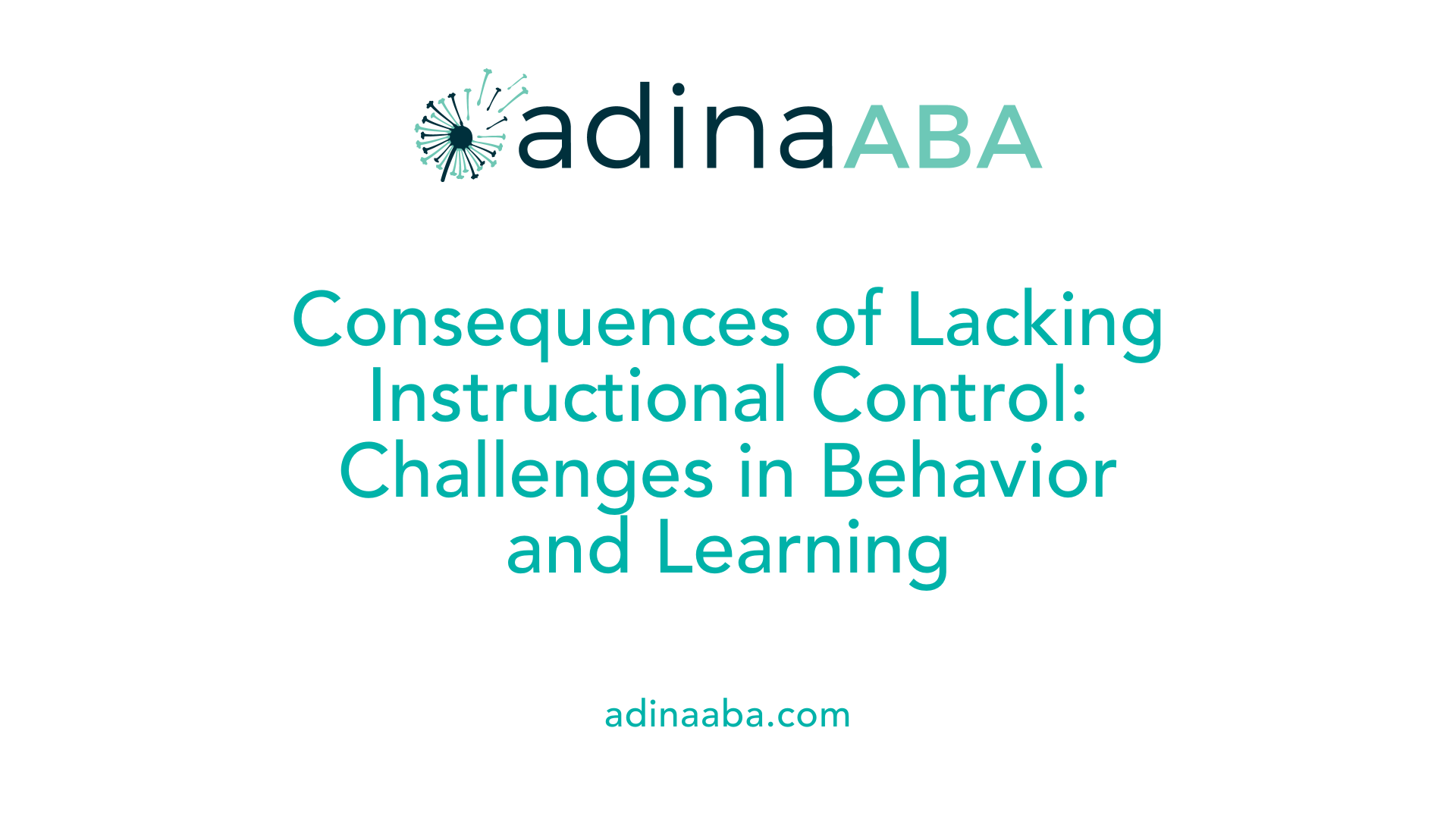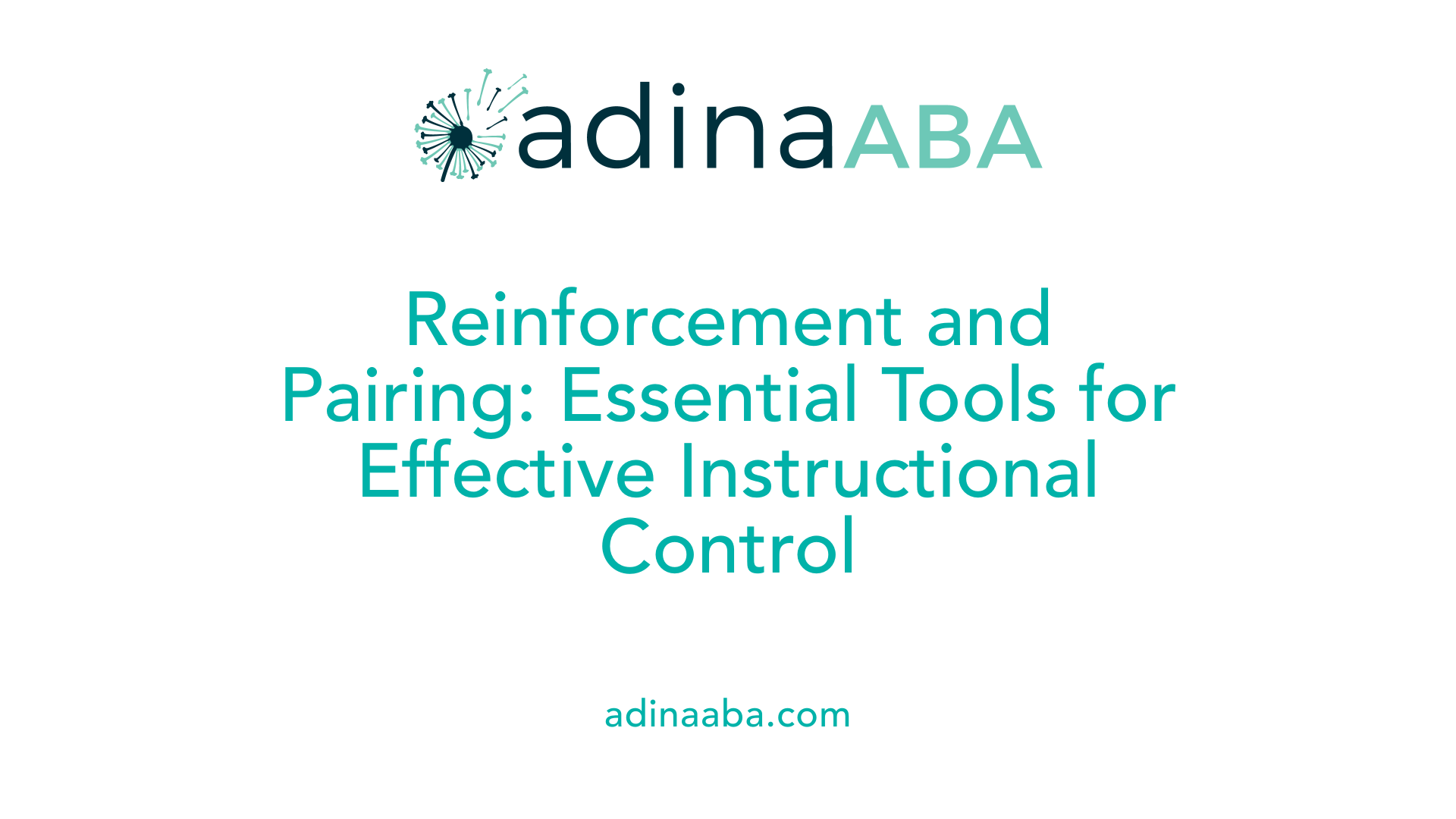What is instructional control and why it matters

Understanding the Foundation of Effective Teaching and Behavior Management
Instructional control is a crucial concept in education and behavioral interventions that focuses on establishing a positive, trusting relationship between instructors—such as teachers, caregivers, or therapists—and learners. When instructional control is effectively developed, it creates an environment where children are motivated to follow directions, collaborate, and develop essential life skills. This article explores what instructional control is, why it’s vital, how to establish and maintain it, and its significance across various developmental contexts, including autism intervention.
What is Instructional Control and Why Does It Matter?

What is instructional control and why is it important in educational and behavioral contexts?
Instructional control refers to the ability of an authority figure, such as a teacher or caregiver, to influence a learner's behavior through directives, rules, and consistent expectations. It creates a positive working relationship where the learner is motivated to listen and follow instructions.
Establishing instructional control is essential because it helps promote compliance and facilitates effective learning. When a learner responds reliably to instructions, it ensures that teaching can proceed smoothly and that desired behaviors are reinforced. This is especially important for children with challenging behaviors, as it provides a structured environment where expectations are clear.
Techniques like pairing preferred activities with the adult, giving clear, direct commands instead of questions, and providing immediate reinforcement when the learner complies help develop this control. For example, saying "Push in your chair" instead of "Can you push in your chair?" establishes a firm expectation.
Building instructional control also enhances the child's sense of security, making interactions predictable and fair. When expectations are consistent across caregivers and settings, the learner is more likely to cooperate and learn new skills effectively. Overall, effective instructional control underpins successful educational and behavioral interventions, leading to improved cooperation, motivation, and the ability to sustain positive behaviors over time.
Implications of Lacking Instructional Control

What does lack of instructional control mean and what are its implications?
Lack of instructional control occurs when a child does not regularly listen or respond to instructions from caregivers or educators. This absence of a positive, dependable relationship reduces the likelihood that the child will follow directions, which can weaken authority figures' influence.
When instructional control is missing, children may show decreased motivation to cooperate. This often results in non-compliance, refusal to complete tasks, and avoidance of routines. Such behaviors can interfere with teaching efforts and hinder overall progress in developing communication, self-help, and social skills.
Without a clear system of expectations and reinforcement, managing behaviors becomes more challenging. The child's environment may feel unpredictable, increasing stress for both the child and the adult.
Establishing instructional control involves consistent use of positive reinforcement, setting clear expectations, and controlling access to preferred items to motivate cooperation. These techniques help children learn that following instructions benefits them, which encourages compliance.
Without these strategies, behavioral interventions and educational activities may become less effective. Children might engage in more problem behaviors or escape behaviors to access more immediate or desirable reinforcement.
Overall, lacking instructional control compromises the foundation for successful teaching and behavior management. It can delay learning, increase behavioral challenges, and make it harder to reach developmental goals. Ensuring that instructional control is established and maintained is essential for creating a positive, effective learning environment and supporting a child's growth.
Key Strategies in Establishing and Maintaining Instructional Control

What are the key steps to establishing and maintaining instructional control?
Establishing and maintaining instructional control is fundamental to successful teaching and behavior management, especially in interventions like ABA therapy. It builds a positive, trusting relationship where the learner becomes motivated to follow directions consistently.
One of the initial steps is controlling access to reinforcers. This means managing how and when a learner receives preferred items or activities, often through proactive strategies such as non-contingent reinforcement, where the learner is given access to reinforcers regularly and freely, encouraging approach behavior and reducing problem behaviors.
Pairing oneself with enjoyable activities and demonstrating that the instructor is fun and trustworthy is crucial. This process, called pairing, helps the child associate the adult with positive experiences, making them more receptive to instructions.
Consistent follow-through with instructions and promises builds trust and establishes clear expectations. Using simple, direct commands and giving reinforcement immediately upon compliance—like praise or access to preferred items—encourages the learner to continue responding appropriately.
Understanding what motivates the learner and aligning reinforcement with their interests helps maintain their engagement and motivation. It also involves recognizing that ignoring instructions or engaging in inappropriate behavior without reinforcement will lead to a decrease in those behaviors, especially when combined with extinction procedures.
Gradually, reinforcement should be delivered intermittently to reinforce consistency while fostering independence. This approach helps the learner understand that following directions is beneficial overall.
Effective instructional control also involves making activities fun and easy, creating a positive experience that motivates cooperation. Building trust and rapport through consistent, predictable behavior across different settings and caregivers ensures stability and effectiveness.
In summary, key steps include:
- controlling access to reinforcers
- pairing with enjoyable activities
- demonstrating trustworthiness
- providing clear, simple instructions
- reinforcing immediately and appropriately
- understanding learner’s interests
- managing maladaptive behaviors through extinction
When these strategies are consistently implemented, they support a cooperative learning environment, reduce challenging behaviors, and improve skill acquisition.
Role of Reinforcement and Pairing in Instructional Control

How important are pairing and non-contingent reinforcement?
Pairing involves associating oneself with positive experiences, where the instructor provides rewards and fun activities to make themselves a desirable presence for the learner. Initially, this is done through non-contingent reinforcement, meaning the learner receives treats, praise, or engaging activities freely, without any specific task required. This approach helps the learner form a positive association with the caregiver or teacher, increasing the likelihood that they will approach and respond positively.
Controlling access to reinforcers is also vital. By limiting immediate access to preferred items and rewarding cooperation, caregivers set the stage for better engagement and compliance. Once the learner is motivated to approach, the instructor can then begin to introduce more structured demands.
Why use social reinforcers such as praise?
Social praise, like saying "Great job!" or offering a warm smile, acts as a powerful conditioned reinforcer. It signals to the learner that they are doing well and encourages continued cooperation. Facial expressions, eye contact, and verbal affirmation are simple yet effective tools for reinforcing desired behaviors.
Using social reinforcers supports instructional control because it creates a positive emotional connection and makes the learning environment enjoyable. When learners associate instructions with kind words and positive reactions, they are more motivated to follow directions.
What is the role of fading prompts and reinforcers?
Fading involves gradually reducing the level of assistance or reinforcement as the learner begins to independently follow instructions. For example, initially, a caregiver might provide frequent praise and high-value reinforcers for compliance. Over time, these prompts and rewards are systematically decreased.
This process helps the child develop internal motivation and confidence in their ability to perform tasks without needing constant external reinforcement. Fading reinforces independence, ensuring that the learner continues to follow instructions even when reinforcers are less frequent.
Overall significance in instructional control
These strategies—pairing, reinforcing with social praise, and fading prompts—are foundational for building and maintaining effective instructional control. They promote a positive, trusting relationship between the learner and their instructor, which is crucial for successful teaching and behavior management.
Goals of Instructional Control
Promoting Cooperation and Motivation
Instructional control aims to foster a positive environment where the learner is motivated to follow instructions voluntarily. By building a trusting relationship through pairing and consistent reinforcement, children become more willing to participate in learning activities. Reinforcement strategies such as immediate praise and access to preferred items help create a stimulus-response bond, making compliance more likely. When a child enjoys interactions and perceives following directions as beneficial, their natural motivation to cooperate increases.
Establishing Safety and Predictability
A core goal of instructional control is to create a sense of stability and security within the learning environment. Consistent routines, clear expectations, and predictable responses from caregivers help children understand what is expected of them. This sense of predictability reduces anxiety and minimizes the likelihood of problematic behaviors. When children know their environment is safe and that instructions will be reliably followed through, they tend to respond more positively to demands.
Reducing Problematic Behaviors
By effectively establishing instructional control, caregivers can decrease behaviors such as refusal, escape, or aggression. When a child's motivation is aligned with positive reinforcement and they trust the authority figure, they are less likely to seek out problematic behaviors as a means of gaining control or avoiding demands. Techniques like withholding reinforcement for non-compliance, combined with extinction procedures, help diminish inappropriate responses. This structured approach promotes compliance and makes behavior management more straightforward.
| Goal | Focus | Methods | Expected Outcome |
|---|---|---|---|
| Promoting cooperation | Encourages voluntary listening and participation | Pairing, reinforcement, showing benefits of following directions | Increased willingness to cooperate and engage |
| Establishing safety | Creates a predictable, secure environment | Consistent routines, clear instructions, positive relationships | Reduced anxiety and behavioral issues |
| Reducing problematic behaviors | Minimizes escape and refusal behaviors | Extinction, withholding reinforcement, managing non-compliance | Fewer challenging behaviors, improved compliance |
The overall objective of instructional control is to develop a child's desire to follow directions independently, which makes teaching more effective and interactions more positive. Achieving these goals requires consistent application of strategies by all caregivers involved, ensuring that reinforcement, pairing, and behavioral management techniques work in harmony to support the child's learning journey.
Benefits for Parents, Teachers, and Clinicians
How does understanding instructional control benefit parents, teachers, and clinicians?
Understanding instructional control offers valuable advantages in various settings such as home, school, and therapy programs. It helps caregivers and educators establish a cooperative and predictable behavior pattern by consistently applying strategies that motivate and guide children.
By developing a child's desire to follow instructions, this approach enhances learning efficiency and behavior management. Caregivers learn to control access to preferred items, pair themselves with fun activities, and provide immediate, positive feedback—all of which foster trust and engagement.
In clinical contexts like autism intervention, instructional control is fundamental. It promotes communication, social skills, and independence while reducing problematic behaviors. For example, using deliberate reinforcement and controlling reinforcer access ensures that children respond reliably to commands, making skill teaching more effective.
Additionally, consistent routines and instructions across caregivers reinforce the child's understanding and cooperation. This consistency is crucial for children with developmental challenges because it creates a sense of security and stability.
Overall, mastery of instructional control empowers parents, teachers, and clinicians to create positive, engaging learning environments. It aids in achieving developmental and behavioral goals, improves interactions, and fosters long-term progress in children’s skill development.
Wrapping Up: The Significance of Instructional Control in Learning and Behavior
Mastering instructional control is fundamental for successful teaching, effective behavior management, and fostering positive developmental outcomes. Through establishing trust, consistency, and motivating reinforcement strategies, educators and caregivers can create environments that promote cooperation, independence, and resilience. Recognizing that instructional control is not about exerting dominance, but rather about building a positive and predictable relationship, underscores its role in supporting long-term learning and social-emotional growth. As understanding and application of these principles expand, the potential for positive change and skill acquisition in children, especially those with behavioral challenges or autism, becomes increasingly attainable, ensuring safer, more engaging, and effective interactions.
References
- Instructional Control: 7 Amazing Steps - ABA-Works
- The Importance of Establishing Instructional Control with Your Child
- What is Instructional Control and, Why Do You Need it?
- Instructional Control Part 1 - KSDE TASN
- Instructional Control: Do's and Don'ts - Sunny Days Sunshine Center
- Learner Cooperation — Establishing Instructional Control
- The Seven Steps to Earning Instructional Control with Your Child
- [PDF] Compliance & Instructional Control | KidsAbility
- Instructional Strategies for Autism: My Struggles as a Parent
- [PDF] Instructional Control
More Resources
Expert Clinicians
Get started today ->


.jpg)
.jpg)
.jpg)

.jpg)